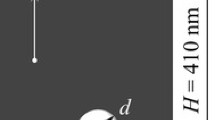Absract
Direct numerical simulation of nanoparticle coagulation in a two-dimensional mixing layer is performed. A sectional model is used to discretize the particulate field resulting in a set of coupled non-linear partial differential equations each representing the concentration of particles of a particular size. The advantage of this approach is that it provides a robust mathematical framework for considering the particulate field as a function of space, time, and size with no apriori assumptions. The spatio-temporal evolution of the particulate field is visualized via the mean particle diameter and also in a size-specific manner.
Similar content being viewed by others
References
Biswas, P., Wu, C. Y., Zachariah, M. R. and McMillen, B. K., In Situ Characterization of Vapor Phase Growth of Iron Oxide-Silica Nanocomposite; Part II: Comparison of a Discrete-Sectional Model Predictions to Experimental Data, Journal of Material Research, 12-3 (1997) 714–723.
Carpenter, M. H., A High-Order Compact Numerical Algorithm for Supersonic Flows, In Morton, K. W., editor, Twelfth International Conference on Numerical Methods in Fluid Dynamics, Lecture Notes in Physics, 371 (1990), 254–258, Springer-Verlag, New York, NY.
Dagani, R., NASA Goes Nano, Chemical Engineering News, (2000).
Garrick, S. C., Lehtinen, K. E. J and Zachariah, M. R., Modeling and Simulation of Nanoparticle Coagulation in High Reynolds Number Incompressible Flows, proc. Joint US Sections Meeting of the Combustion Institute, (Oakland, CA), (2001).
Gelbard, F., Tambour, R. and Seinfeld, J. H., Sectional Representations for Simulating Aerosol Dynamics, Journal of Colloid and Interface Science, 76-2:541–556.
Gelbard, F. and Seinfeld, J. H., Simulation of Multi-component Aerosol Dynamics, Journal of Colloid and Interface Science, 78-2 (1980), 485–501.
Fuchs, N. A., The Mechanics of Aerosols, Pergamom, Toronto, CA, (1964).
Givi, P., Model Free Simulations of Turbulent Reactive Flows, Progress in Energy Combustion Science, 15 (1989), 1–107.
Kennedy, C. A. and Carpenter, M. H., Several New Numerical Methods For Compressible Shear-Layer Simulations, Applied Numerical Mathematics, 14 (1994), 397–433.
MacCormack, R. W., The Effect of Viscosity in Hypervelocity Impact Catering, AIAA Paper 69-354 (1969).
Matsoukas, T. and Friedlander, S. K., Dynamics of Aerosol Agglomerate Formation, Journal of Colloid and Interface Science, 146-2 (1991), 495–506.
Modem, S., Garrick, S.C., Lehtinen, K. E. J., and Zachariah, M. R., Direct Numerical Simulation of Nanoparticle Coagulationi in Temporal Mixing Layers, proc. the (29th) Int. Symposium on Combustion, (in press).
Ottino, J. M., The Kinematics of Mixing: Stretching, Chaos, and Transport, Cambridge University Press, Cambridge, UK, (1989).
Pratsinis, S. E., Flame Aerosol Synthesis of Ceramic Powders, Progress in Energy Combustion Science, 24 (1998) 197–219.
Pratsinis, S. E. and Kim, K.S., Particle Coagulation, Diffusion, and Thermophoresis in Laminar Flows, Journal of Aerosol Science, 20 (1989), 101–111.
Prupacher, H. R. and Klett, J. D., Microphysics of Clouds and Precipitation, Reidel, Dordrecht, Netherlands, (1978).
Pyykonen, J. and Jokiniemi, J., Computational Fluid Dynamics Based Sectional Aerosol Modelling Schemes, Journal of Aerosol Science, 31 (2000), 531–550.
Wooldridge, M. S., Gas Phase Combustion Synthesis of Particles, Progress in Energy Combustion Science, 24 (1998) 197–219.
Xiong, Y. and Pratsinis, S. E. Formation of Agglomerate Particles by Coagulation and Sintering, Part-I. A 2-d Solution of the Population Balance Equation, Journal of Aerosol Science, 24 (1993), 283–300.
Zachariah, M. and Semerjian, H., Simulation of Ceramic Particle Formation: Comparison With In-Situ Measurements, American Institute of Chemical Engineering Journal, 35 (1989), 2003–2012.
Author information
Authors and Affiliations
Additional information
Sean Garrick: He is the Nelson Assistant Professor of Mechanical Engineering at the University of Minnesota — Twin Cities. Professor Garrick obtained his Ph.D. in Mechanical Engineering at the State University of New York at Buffalo in 1998. His research interests include turbulent reacting flows, stochastic processes, aerosols, large eddy simulation, and heat transfer.
Sriswetha Modem: She is a Ph.D. candidate in the department of Mechanical Engineering at the University of Minnesota — Twin Cities. Ms. Modem received her M.S. degree in 2001 from the Department of Mechanical Engineering at the University of Minnesota — Twin Cities. Her research interests include computational fluid dynamics, reacting flows, mixing layers, and jets.
Rights and permissions
About this article
Cite this article
Modem, S., Garrick, S.C. Nanoparticle coagulation in a temporal mixing layer mean and size-selected images. J Vis 6, 293–302 (2003). https://doi.org/10.1007/BF03181470
Received:
Revised:
Issue Date:
DOI: https://doi.org/10.1007/BF03181470




